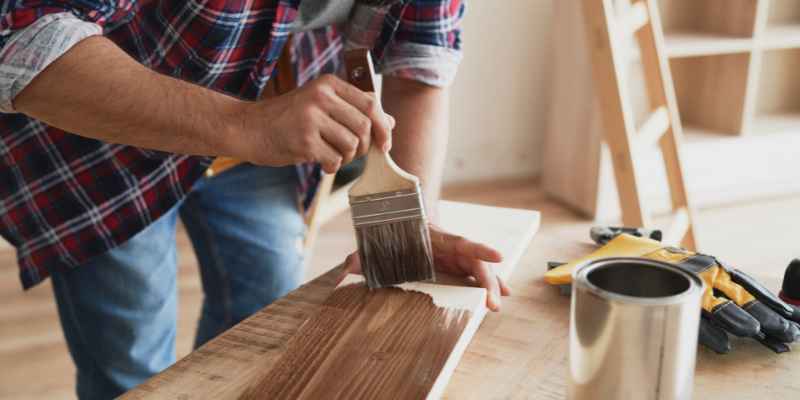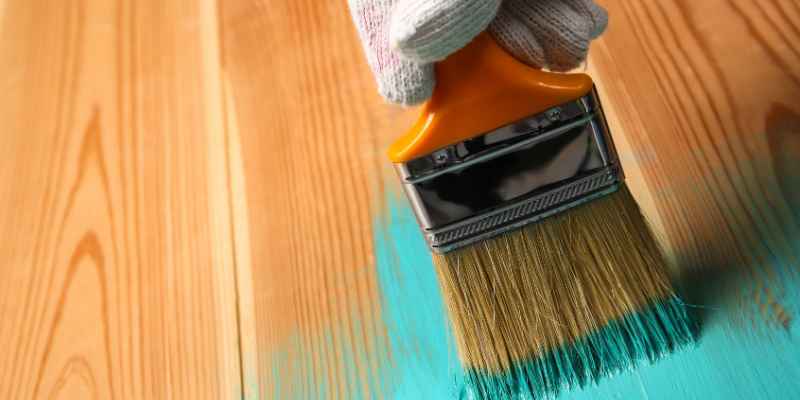Painting wet or damp wood is not recommended as it prevents proper adhesion and can lead to paint failure. Painting wet or damp wood can cause paint failure and improper adhesion.
It is important to ensure that the wood is completely dry before applying paint to achieve the best results. Moisture in the wood can cause the paint to blister, peel, or chip off over time. Additionally, painting wet wood can trap moisture underneath the paint, leading to rot and decay.
To properly paint wood, it is essential to allow it to dry thoroughly to avoid these issues and ensure a long-lasting and attractive finish.
Is It Possible To Paint Wet Wood?
As a homeowner or DIY enthusiast, you may have encountered situations where you need to paint wood surfaces. But what if the wood is wet or damp? Can you still paint it? In this article, we will explore the possibility of painting wet wood and discuss the factors to consider when determining the moisture content of the wood. We will also delve into the effects of painting wet wood and provide some practical tips for achieving a successful paint job. Let’s dive in!
Determining The Moisture Content
Before attempting to paint wet wood, it is crucial to assess its moisture content. Painting wood that is overly wet can lead to numerous issues down the line. To determine the moisture content of the wood, follow these simple steps:
- Use a moisture meter: These handy devices are widely available and can provide accurate readings of moisture levels in wood. Simply insert the prongs into the wood surface and allow the meter to display the results.
- Visual inspection: Check for visible signs of moisture, such as water droplets or condensation on the surface. Examine the wood for any discoloration, warping, or softness, as these are indications of excessive moisture.
By accurately determining the moisture content of the wood, you can make an informed decision on whether or not it is suitable for painting. Ideally, the wood should have a moisture content of 12% or less before painting.
Effects Of Painting Wet Wood
Attempting to paint wet wood without proper drying can result in a range of negative consequences. Here are a few effects to consider:
- Adhesion issues: Paint applied to wet wood may not adhere properly, leading to peeling, flaking, or blistering of the paint film.
- Uneven finish: The excess moisture in the wood can cause the paint to spread unevenly, resulting in an inconsistent finish.
- Mold and mildew growth: Painting over wet wood creates a favorable environment for mold and mildew to thrive, leading to potential health hazards and degradation of the wood.
- Longer drying time: If you paint wet wood, it will take much longer to dry, prolonging the overall project completion time.
With these potential issues in mind, it is essential to ensure the wood is properly dried before proceeding with painting. Once the moisture content is within the recommended range, you can confidently move forward with your paint application.

Preparation Steps For Painting Wet Wood
When it comes to painting wet wood or damp wood, proper preparation is key to achieve a long-lasting and professionally finished result. Failing to adequately prepare the wood surface can lead to paint blistering, peeling, or not adhering properly. In this section, we will discuss the essential steps to prepare wet wood for painting, including drying the wood surface, using a moisture meter, and applying a primer.
Drying The Wood Surface
Drying the wood surface is crucial before painting wet wood. Moisture trapped within the wood needs to be evaporated to ensure optimal paint adhesion. Here are the steps to properly dry the wood surface:
- Remove any standing water or excess moisture from the wood using a towel or sponge.
- Place the wet wood in a dry and well-ventilated area, allowing air circulation around the surface.
- Use a dehumidifier or fans to help speed up the drying process.
- Make sure the wood is completely dry to touch before proceeding with the next steps.
Using A Moisture Meter
Using a moisture meter is a reliable and efficient way to determine if the wood has reached the desired moisture content for painting. Follow these steps when using a moisture meter:
- Choose a high-quality moisture meter specifically designed for wood.
- Ensure the electrodes of the moisture meter are clean and in good condition.
- Insert the electrodes into the wood surface, following the manufacturer’s instructions.
- Read and note the moisture percentage displayed on the meter.
- Wait for a few hours and retest different areas of the wood surface to ensure consistent moisture levels.
- Continue with the painting process only when the wood moisture content is within the recommended range.
Applying A Primer
Applying a primer to wet wood is essential to seal the surface, provide adhesion, and prevent moisture-related issues. Follow these steps when applying a primer:
- Choose a high-quality primer suitable for the type of paint and the wood surface.
- Ensure the wood surface is clean, dry, and free from any loose or flaking paint.
- Apply the primer using a brush or roller, following the manufacturer’s instructions for drying time between coats.
- Allow the primer to cure completely before applying the paint.
By following these preparation steps, you can ensure that your paint job on wet wood will be successful, durable, and visually appealing. Remember to always check the manufacturer’s instructions for the specific products you are using and consult a professional if you are unsure about the process.
Tips For Painting Damp Wood
Painting damp wood can lead to uneven results and potential damage. Before beginning, ensure the wood is thoroughly dry, using a moisture meter if necessary. Sand the surface to remove any loose paint or debris and use a primer designed specifically for damp or wet wood.
Assessing The Moisture Level
Before painting damp wood, it is crucial to assess the moisture level to ensure a successful paint job. One way to check the moisture content is by using a moisture meter, which measures the amount of moisture present in the wood. If the moisture level is above 15%, it is considered too damp for painting. Another simple method is to press a plastic sheet tightly against the wood surface and leave it for 24 hours. If condensation forms on the inside of the plastic, the wood is still too wet to paint.
Allowing Adequate Drying Time
Once you have determined that the wood is slightly damp rather than wet, it is essential to allow it to dry properly before beginning the painting process. This step cannot be rushed, as painting on still damp wood can lead to paint failure and a lackluster finish. Depending on the weather conditions, the drying time can vary. In general, it is recommended to wait at least 24 to 48 hours for the wood to dry completely. Avoid painting if rain or high humidity is expected, as this can disrupt the drying process.
Choosing The Right Paint
When painting damp wood, it is crucial to choose the right type of paint that is specifically formulated for moist conditions. Look for paints that are labeled as “water-resistant” or “mold-resistant” to ensure they can withstand the moisture present in the wood. Latex or acrylic-based paints are generally suitable for damp wood. These paints have good adhesion properties and allow the wood to breathe, preventing moisture buildup. It is also recommended to use an exterior-grade primer before applying the paint, as it helps improve adhesion and durability.
By following these tips, you can successfully paint damp wood and achieve a long-lasting and visually appealing finish. Remember to assess the moisture level, allow adequate drying time, and choose the right paint to ensure the best results. Happy painting!
Common Mistakes To Avoid
When it comes to painting wood, one of the most common mistakes people make is attempting to paint wet or damp wood. This can lead to a variety of issues, including poor adhesion, peeling, and a rough finish. To ensure a successful and long-lasting paint job, it’s important to avoid the following common mistakes:
Skipping Proper Drying
One of the biggest mistakes you can make when painting wood is skipping the proper drying process. It’s crucial to give the wood enough time to dry completely before applying any paint. If you rush this step, the moisture trapped in the wood can cause the paint to bubble and peel. To ensure the wood is thoroughly dry, it’s recommended to wait at least 24 hours after rain or washing.
Using Incompatible Paint
Using the wrong type of paint for wet or damp wood is another common mistake that can lead to disappointing results. When the wood is not completely dry, it’s important to use a specialized paint that is designed to adhere to moisture-prone surfaces. Look for paints labeled as “mold-resistant” or “moisture-resistant.” These formulas contain additives that help the paint bond effectively to the wood and prevent future moisture damage.
Not Sealing The Wood
To further protect the wood from moisture and ensure the longevity of your paint job, it’s crucial to seal the wood before painting. This step creates a barrier that prevents moisture from penetrating the wood and causing issues down the line. There are various sealing products available, such as wood sealers or primers designed specifically for wet or damp wood. Applying a layer of sealer or primer will not only improve adhesion but also provide an extra layer of protection against moisture-related damage.
Avoiding these common mistakes will help you achieve a successful paint job on wet or damp wood. Remember to allow sufficient drying time, choose the right type of paint, and seal the wood before painting. By taking these steps, you’ll ensure a long-lasting, beautiful finish that withstands the effects of moisture.

Alternative Options For Wet Or Damp Wood
Dealing with wet or damp wood can be a challenge, but fear not! There are alternative options available to help you salvage your wood and prevent further damage. Here are some effective ways to address wet or damp wood:
Using Wood Sealers
Wood sealers are a great solution for treating wet or damp wood. These products are designed to penetrate the wood fibers, creating a protective barrier that helps prevent moisture from seeping in. By applying a wood sealer, you can seal the wood, allowing it to dry naturally without causing any further damage. Make sure to choose a sealer designed specifically for wet or damp wood, as regular sealers may not be as effective.
Replacing Damaged Wood
In some cases, the wood may be too damaged or rotten to salvage. When this happens, the best option is to replace the damaged wood altogether. By removing the wet or damp wood and replacing it with new and dry wood, you can ensure the structural integrity of your project. This is especially important for outdoor projects, as wet wood can lead to further decay and deterioration.
Professional Assistance
Sometimes, the extent of the damage or the complexity of the project may require professional assistance. Hiring a professional woodworker or contractor can ensure that the wet or damp wood is properly addressed and that the necessary steps are taken to prevent future issues. They have the skills and experience to evaluate the situation and provide the most suitable solution. Additionally, professionals have access to specialized tools and equipment that can make the process more efficient.
If you are unsure about the best course of action or if you lack the expertise, it is always wise to seek professional assistance when dealing with wet or damp wood.
Conclusion
Painting wet or damp wood is not recommended as it can lead to poor adhesion, blisters, and peeling. It is crucial to allow the wood to dry completely before applying paint to ensure a durable and long-lasting finish. Proper preparation, including sanding and priming, is essential for the best results.
By following these guidelines, you can achieve a beautiful and professional paint job on dry wood.


